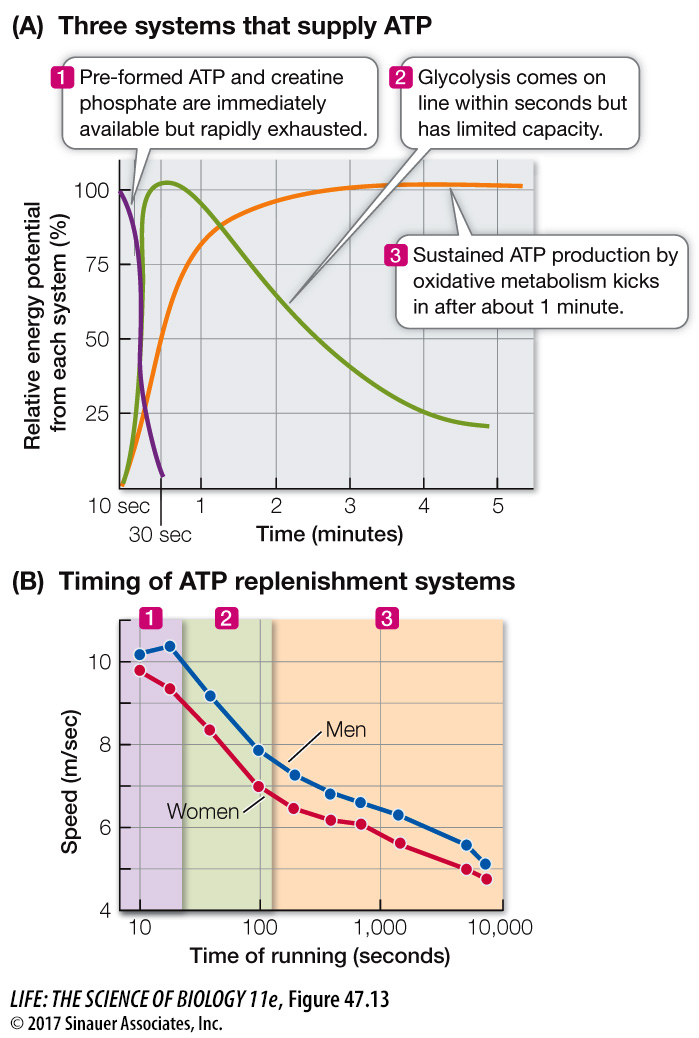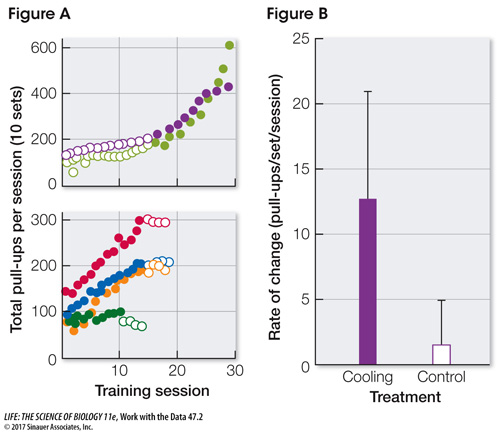Muscle ATP supply limits performance
Muscles have three systems for supplying the ATP they need for contraction:
The immediate system uses preformed ATP and creatine phosphate.
The glycolytic system metabolizes carbohydrates to lactate and pyruvate.
The oxidative system metabolizes carbohydrates or fats all the way to H2O and CO2.
The capacity of these three systems and the rates at which they can produce ATP determine both work capacity and endurance of a muscle (Figure 47.13).

Question
Q: Figure 47.13B shows how maximum speed decreased as the duration of the running events got longer. Explain why there are three different slopes for this curve.
The slopes of the curves are influenced by the time course of the mechanisms supplying the ATP supporting the activity. Because the first 10–20 seconds of high-
ATP is present in muscles in very small amounts. However, muscle fibers also contain a storage compound called creatine phosphate (CP). This molecule stores energy in a phosphate bond that it can transfer to ADP. The total energy available in all the muscles of your body in the form of ATP and CP—
The glycolytic system activates within a few seconds to replace the ATP depleted at the onset of muscle activity. The glycolytic enzymes are located in the cytoplasm of the muscle fiber, and therefore the ATP they generate is rapidly available to the myosin filaments. However, as noted in Chapter 9, glycolysis alone is an inefficient way to produce ATP, and it leads to the accumulation of lactic acid, which slows the process. Thus the glycolytic system and the immediate system together provide the energy needed by active muscles for less than a minute (see Figure 47.13). Fortunately, oxidative metabolism becomes fully active in about a minute, producing relatively huge amounts of ATP because it can completely metabolize carbohydrates and fats to CO2 and water. However, it requires many reactions, and it takes place in the mitochondria, so O2 and substrate must get into the mitochondria, and the formed ATP must get from the mitochondria to the myosin filaments in the muscle. These processes are not instantaneous, so the rate at which oxidative metabolism can make ATP available to do work is slower than the rate at which the other two systems can supply ATP.
1013
The *fuel resources available to the muscles influences how long someone can sustain a high level of aerobic exercise. From the circulating blood, muscle receives glucose and free fatty acids that it metabolizes to generate ATP. At high levels of aerobic exercise, however, most of the fuel used by muscles to produce ATP comes from the reserve of glycogen stored in the muscle itself. Depletion of muscle glycogen contributes to fatigue.
*connect the concepts The work performance curves for different activities reflect the complexity of the biochemical processes by which different fuel sources are metabolized to product ATP. Glycolysis supports anaerobic activities and it only entails ten enzymatic steps, so it can come on fast (see Key Concept 9.2). For aerobic activity the citric acid cycle and the respiratory chain reactions add more steps and limit the rate of ATP production.
The rate at which muscle glycogen is replenished depends on diet. Glycogen is quickly replenished with a high-
work with the data
Does Heat Cause Muscle Fatigue?
Original Paper: Grahn, D. A., V. H. Cao, C. M. Nguyen, M. T. Lieu and H. C. Heller. 2012. Work volume and strength training responses to resistive exercise improve with periodic heat extraction from the palm. Journal of Strength and Conditioning Research 26: 2558–
Physical conditioning requires repeated intense physical activity, and the capacity of such workouts is limited by muscle fatigue. Because metabolic heat production raises the temperature of muscles during workouts, it is possible that the rise in temperature contributes to muscle fatigue and limits the capacity of workouts. To test this idea, investigators used rapid-
QUESTIONS
Question 1
What do these data indicate about the possible role of muscle temperature in muscle fatigue?
If the workout capacity goes up with cooling, that suggests that the heat extraction is enabling more work, or in other words, decreasing muscle fatigue that otherwise limits workout capacity.
Question 2
What do these data indicate about the relationship between workout capacity and physical conditioning effects?
Cooling increased the work capacity for each workout in comparison to the previous workout, and over time, the rate of change of capacity was much greater with cooling than without. This difference in rate of change indicates that increasing work capacity (Figure A) leads to increased rate of conditioning (Figure B).

The Effect of Cooling on Workout Capacity (A) The results for individual subjects. Open symbols indicate control treatment, closed symbols indicate cooling treatment; different colors indicate different subjects. (B) The slopes of the lines in Figure A show the rates of increase in workout capacity over the course of the experiment. Mean ± standard deviation of rate of change in pull-
A similar work with the data exercise may be assigned in LaunchPad.